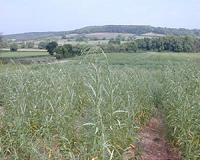 |
Anaheim CA (SPX) Apr 06, 2011 In a scientific advance literally plucked from the waste heap, scientists have described a key step toward using the billions of pounds of waste chicken feathers produced each year to make one of the more important kinds of plastic. They described the new method at the 241st National Meeting and Exposition of the American Chemical Society, being held here this week. "Others have tried to develop thermoplastics from feathers," said Yiqi Yang, Ph.D., who reported on the research. "But none of them perform well when wet. Using this technique, we believe we're the first to demonstrate that we can make chicken-feather-based thermoplastics stable in water while still maintaining strong mechanical properties." Thermoplastics are one of two major groups of plastics, and include nylon, polyethylene, polystyrene, polyvinyl chloride, and dozens of other kinds. They are used to make thousands of consumer and industrial products ranging from toothbrush bristles to soda pop bottles to car bumpers. Thermoplastics got that name because they need heat (or chemicals) to harden from a liquid into a final shape, and can be melted and remolded time and again. The other group, thermosetting plastics, harden once and can't be remelted again. Yang pointed out that both kinds of plastics are made mainly from ingredients obtained from oil or natural gas. Because of concerns about petroleum supplies, prices, and sustainability, dozens of scientific teams are working to find alternative ingredients. One major goal is to use agricultural waste and other renewable resources to make bioplastics that have an additional advantage of being biodegradable once discarded into the environment. "We are trying to develop plastics from renewable resources to replace those derived from petroleum products," said Yang, who is an authority on biomaterials and biofibers in the Institute of Agriculture and Natural Resources at the University of Nebraska-Lincoln. "Utilizing current wastes as alternative sources for materials is one of the best approaches toward a more sustainable and more environmentally responsible society." Chicken feathers are an excellent prospect, Yang explained, because they are inexpensive and abundant. Few shoppers think about it, but every shrink-wrapped broiler in the supermarket cooler leaves behind a few ounces of feathers. Annually there are more than 3 billion pounds of waste chicken feathers in the United States alone. These feathers can be processed into a low-grade animal feed, but that adds little value to the feathers and may also cause diseases in the animals. All too often, they become a waste disposal/environmental pollution headache, incinerated or stored in landfills. Yang explained that chicken feathers are made mainly of keratin, a tough protein also found in hair, hoofs, horns, and wool that can lend strength and durability to plastics. Yang added that the mechanical properties of feather films outperform other biobased products, such as modified starch or plant proteins. To develop the new water-resistant thermoplastic, Yang and colleagues processed chicken feathers with chemicals, including methyl acrylate, a colorless liquid found in nail polish that undergoes polymerization - that's the process used in producing plastics in which molecules link together one by one into huge chains. This process resulted in films of what Yang's group terms "feather-g-poly(methyl acrylate)" plastic. It had excellent properties as a thermoplastic, was substantially stronger and more resistant to tearing than plastics made from soy protein or starch, and as a first among chicken-feather plastics had good resistance to water.
Share This Article With Planet Earth
Related Links American Chemical Society Bio Fuel Technology and Application News
 Short Rotation Energy Crops Could Help Meet UK's Renewable Energy Targets
Short Rotation Energy Crops Could Help Meet UK's Renewable Energy TargetsSouthampton, UK (SPX) Apr 06, 2011 Planting short rotation energy crops on England's unused agricultural land could produce enough biomass to meet renewable energy targets without disrupting the food industry or the environment, according to research led by Professor Gail Taylor from the University of Southampton. The study, funded by the UK Energy Research Centre (UKERC), is a rare investigation into energy crop supply whi ... read more |
|
| The content herein, unless otherwise known to be public domain, are Copyright 1995-2010 - SpaceDaily. AFP and UPI Wire Stories are copyright Agence France-Presse and United Press International. ESA Portal Reports are copyright European Space Agency. All NASA sourced material is public domain. Additional copyrights may apply in whole or part to other bona fide parties. Advertising does not imply endorsement,agreement or approval of any opinions, statements or information provided by SpaceDaily on any Web page published or hosted by SpaceDaily. Privacy Statement |